Building a DIY grow tent can be an ideal option for growers on a budget or those that need a custom footprint not offered by traditional grow tents. In many areas of the world, grow tents aren’t available to buy or are a risky purchase for growers on the down-low. Fortunately, you can purchase the materials needed for a homemade grow tent at a local hardware or department store. This article will review a few styles, materials, and step-by-step instructions for constructing your DIY grow tent.
Growers may be intimidated by building their own home grow tent. Still, with our instructions, the process is easy for anyone to follow. Building your own grow tent will take more time to construct, but you can customize them to your needs and still be cost-effective compared to traditional grow tents. Before diving into grow tent materials and construction methods, let’s explore the Top 5 DIY grow tent styles.
Ideas for a cheap DIY grow tent
PVC frames
These are the most common because of their customizability. With the right connectors and a handsaw, PVC-style tents can be built quickly, easily, and cheaply to fit any footprint.


Foam board insulation
This material makes building a square or rectangular grow space amazingly simple. A bonus is that this DIY grow tent material already has a reflective surface and offers a level of insulation, aka environmental control.


Blackout curtain w/ door
Specifically made out of common grow tent material, this is a great option for growers looking to convert a closet. This option also works great for blocking off a corner nook or an entire portion of any room.


Rolling rack with adjustable shelves
An ideal option for seedling/cloning/vegging, rolling carts can be moved around the room to make space. Construction is simplified by using wire shelves to attach lighting and other grow equipment.


Portable wardrobe
This option is wider than most rolling carts, allowing growers to flower plants in this DIY grow tent. The bar for hanging clothes works great for hanging lights and other grow equipment.
Just make sure the material of this wardrobe isn’t too cheap. The support bar needs to be able to carry the weight of your grow equipment, and the fabric needs to be moisture resistant, otherwise you risk the development of mold within your grow tent.




Shop Indoor Seeds
- Indoor-thriving plants
- For windowsill or under lamps
- Feminized and autoflowers seeds
Important properties all DIY grow tents should have
Materials need to meet specific standards to be considered a viable option:
Lightproof
Photoperiod cannabis plants need uninterrupted periods of darkness for the flowering cycle. Light interruptions during this time can cause undesirable expressions in the plant, leading to hermaphroditism. Even autoflowers benefit from periods of rest that uninterrupted darkness brings.
Waterproof
This especially applies to the material you use for the floor. Water will inevitably spill in the tent. Materials that absorb moisture can be a trap for mold and pathogen growth. There are often high levels of moisture in grow tents, which is why the walls and ceiling should also be constructed using waterproof materials.
Airflow
To exhaust air from your DIY grow tent, you will need the ability to cut holes in the material. Growers must also consider mounting locations inside to attach a fan(s).
Height
Growers may have seen DIY grow boxes and looked to repurpose an old cardboard box or something similar. Where that runs into issues is the amount of space remaining after a grow light is mounted and properly positioned above the canopy. Common heights for grow tents range from 5’ to 8’ (152 to 244 cm).
Durability
Can the material chosen support the weight of your grow equipment? Some materials get less rigid the longer they are. PVC is a good example; the thickness you choose will correlate with its durability. We recommend a minimum of 1”-1.5” (2.5 – 3.8 cm) thickness when using PVC for framing.
Before you build: The amount of plants determine the size of your grow tent
Our list of grow tent materials will help you construct your very own grow space, but you first need to know what size you are aiming for. Will your homemade grow tent fit in a closet, a corner, or an open area? How many plants do you want to grow?
The answer to that question will dictate the size of your DIY grow tent. Because ILGM wants to make every grower a successful grower, we’ve created the article “How many plants fit in your grow tent” to assist.
The final size will partially determine the cost of your grow tent materials. The minimum suggested size is 2’x2’x4’ (61x61x122 cm). Closet spaces are frequently 2’x4’ (61×122 cm); DIY grow tents can be created to fit those dimensions perfectly. Growers who plan to grow more than a couple of plants regularly choose a 3’x’3’x6’ (92x92x183 cm) or a 4’x’4’x7’ (122x122x213 cm) size.
Materials to build your DIY grow tent
What materials to use for the frame of a DIY grow tent
PVC
This material is waterproof, easy to cut, and can be formed into any footprint desired. To build a frame for a 3’x3’x6’ DIY grow tent, gather 48’ (1,463 cm) of PVC and an additional 9’ (274 cm) section to be used as three support bars to hang equipment. Individual pieces of 10’ (305 cm) PVC would cost roughly $7.25 for 1” (2.5 cm) PVC and $11.50 for 1.5”(3.8 cm). You’ll also need six pieces plus the connectors to assemble the tent frame.
Materials:
8 – 90degree joints with three inputs @ roughly $2.00 per
6- T-bar joints @ roughly $1.00 per
Costs:
Roughly $65 +tax for 1” PVC / $90 + tax for 1.5” PVC
Wood
Using wood as your frame provides more durability than PVC, but it is not waterproof. When using 2”x2” (5×5 cm) wood for a frame, a major concern is that the wood absorbs moisture and harbors mold. Keep a clean tent, don’t let water pool near the frame. Using a wood frame with insulated panels is the ideal match.
This combination makes a sturdy tent that is 4’x4’x8’ (122x122x224 cm) with only a few cuts to make.
Materials:
9 – 2”x2”x8’ (5x5x224 cm) pieces. Each piece costs roughly $3.25.
A box of 2” screws to attach the frame and the insulation.
Costs:
Roughly $35 for wood and screws
Metal
Prefabricated metal units are often more cost-effective than constructing a custom metal frame. Custom metal frames can be heavy and defeat the purpose of being quick and easy. Prefabricated items like adjustable shelf wire racks and portable wardrobes can work well for seedlings, clones, and early vegetative plants.
Wire rack options may be too narrow to act as an effective flowering area. Still, with the right plant training, anything is possible. Check out our article on low stress training for cannabis. This DIY grow tent option works well for closet spaces and is similar to 2’x4’ grow tents.
Cost for prefabricated but repurposed unit = between $30 and $75
Other considerations
Waterproof material
Regardless of what growers choose for a frame, they will want to make the floor area waterproof. This item should include a raised edge to prevent standing water from running out. This is especially handy for hydroponic setups.
Common materials used are plastic or rubber. Drip pans come in all shapes and purposes. Some are for dog kennels, others for automotive purposes, but you will likely find a plastic drip pan that fits your desired footprint with a small amount of searching.
Cost: Between $20 and $40
Lightproof and reflective material
Many growers underestimate the strength of light. Trash bags are dark, making some growers think they are a good DIY grow tent fabric. Then they turn on the grow light and discover how much light is still coming through the material.
Because being lightproof is absolutely critical, there are only a few “ideal” materials to use. Foam board insulation has the advantage of being lightproof and reflective.
Dark polyethylene film (plastic sheets, also called vapor barrier) can be used for the outside of the DIY grow tent. You’ll need multiple layers, but it is commonly sold in 100ft rolls, which is far more than needed.


Although that DIY grow tent material seals out light, it doesn’t reflect the light inside the tent. The thicker the millimeter you can afford, the better the light-blocking ability will be.
Reflectivity is also an important part of the grow tent material you choose, but don’t start lining your walls with tin foil. White-colored wall coverings, as well as shiny mylar, work well for this purpose. Panda film has a dark outside layer with a reflective white on the inside. This material reduces the amount of work by having both materials in one piece.


Costs:
- Vapor barrier is roughly $25
- Mylar is roughly $35
- Panda film material is roughly $50
- Foam board insulation is roughly $17 per 1”x4’x8’ piece
Airflow
Airflow is an inescapable necessity whether you purchase a grow tent or build your own. Air will need to be moved within the tent as well as extracted. Ideally a small fan will move air above the canopy, and another fan will move air below the canopy. Depending upon tent size, these can be accomplished using 4” or 6” fans.
The same goes for extraction fans. A 4” or 6” model will be sufficient to exhaust and exchange the air in your DIY grow tent.


Costs:
- Circulation fans average $10 to $15
- In-line fans average $50 to $100
Grow lights
Growers using a homemade grow tent should avoid HID systems like high-pressure sodium (HPS) and metal halide (MH) because they produce too much heat. LED systems are the ideal choice, but some growers will use CFL bulbs if the grow area or grow budget is smaller.
The size of your DIY grow tent will help determine the size of LED that is right for the situation. A general rule is 35W to 40W per sq. ft. The minimum wattage we’d recommend in a 2’x2’ tent is 100W. Regardless of the LED chosen, the lights all come with hanging systems that allow growers to attach the lights to ratchets. If you want more information on hanging your lights, check out our “beginners guide to hanging grow lights”
You can be budget conscious but still find good quality with many popular LED brands. Companies with quality lights in the budget category include Spider Farmer, Mars Hydro, Vipa, rspectra, and Vivosun.
Cost:
Roughly $100 per 100W
Tools and other materials
- Hacksaw with PVC blade or handsaw for wood
- Duct tape
- HVAC foil tape
- 4” or 6” duct collar
- Peel and stick zipper
- Fresh razor/box knife
- Tape measurer
- Clips or clamps to act as a second pair of hands
Total Budget
| frame | covering | others | time | # of tools | Lights/fans | Total $ | |
| PVC | $90 | $50 | $50 | 2 hrs | 8 | $300 | $490 |
| Wood | $35 | $85 | $35 | 1.25 hrs | 6 | $300 | $455 |
| Metal | $65 | $50 | $35 | 1 hr | 5 | $300 | $450 |
| Store | $125 | – | – | 20 min. | 0 | $300 | $425 |
How to build a DIY grow tent with PVC frame
For this example, we will use a 3’x3’x6’ footprint for our tent. It is important to cut each piece of PVC to length, but the covering should always be cut longer than needed. We will want to have overlap of the outer pieces as we enclose our DIY grow box.
Part One:
1. Cut eight 36” pieces (top and bottom), four 72” pieces (vertical poles), and three 33” pieces (upper support bars).
2. Build a square on the ground using four 36” pieces and four 90-degree joints with three inputs.
3. Repeat step two, then place the three upper support bars evenly spaced within the square.
4. Take three T-bar joint adapters and line them up with the support bars on each side.
5. Mark on the solid 36” piece (each side) of PVC where cuts will be made to add the T-bar joint.
6. Make the first cut on each side and attach the T-bar joints.
(*Note – because the adapter can add an inch of length to the connecting piece, you should cut one piece, add the T-bar joint and remeasure the next cut to keep your support bars equally spaced. You will have a few inches of scrap PVC even though the 36” length is still the same.)
7. Attach the support bars into the T-bar joints, which will complete the top of our grow tent frame.
8. Cut a piece of panda film roughly 40”x40”. This will be the grow tent material for the bottom.
9. Place the PVC square base on the panda film, the white side facing up.
10. Using duct tape, secure the panda film to the PVC.
11. Place the four 72” pieces into the lower 90-degree joints.
12. Attach the top 90-degree joints to the upright poles. This completes the frame construction.
Total time needed:
30 minutes
Part Two
13. Position the panda film upright, but touching the floor. Clamp the loose edge to any pole.
14. Gently wrap to frame (black side out / white side in) with the panda film until three sides are covered.
15. Firmly secure the end of the panda film that was clamped to the pole. Attach it by using duct tape.
16. One side at a time, starting with the first pole, connect the panda film to the bottom piece of panda film by using duct tape. Do not leave any space without tape. Sealing it completely helps block light leaks.
17. Cut the length of the panda film slightly past the third pole (one side remains open) and attach it to the pole using duct tape.
18. Repeat steps 13-17 to create a second layer of light protection, but use the HVAC tape this time. This aluminum tape blocks intense light from escaping seams and cracks.
Total time needed:
30 minutes
Part Three:
19. Cut two pieces of panda film to 40”x56”. The longer side should overlap the two covered sides of the tent, with equal distance overlapping each side. This reinforced area is where we will later cut exhaust holes.
20. Attach the first layer, starting with the open side of the tent, by using duct tape. Attach the second layer using the HVAC tape. Be sure to leave a little slack in the top when attaching it. You’ll need the slack to pass electrical plugs between the top support bars and the roof.
21. Cut two pieces of panda film to 43”, lay them tight on the ground (no wrinkles). Tape the edges together all the way around with duct tape
22. Attach this piece covering the empty side of the frame, with an equal overlap on each side. Use HVAC tape to attach the sides, top, and bottom.
23. Position the peel-and-stick zipper in the middle of the side in step 22. Remove the paper backing and stick the zipper onto the panda film.
24. Unzip the zipper and use a razor blade or scissors to cut the panda film. Once cut, use HVAC tape to keep the two freshly cut layers of panda film from separating. Zip the DIY grow tent back up.
Total time needed:
15 minutes
Part Four:
25. On either of the sides that now has four layers of panda film, use duct tape to frame either a 4” or 6” empty square where the exhaust duct will go. Using tape to make a square prevents the material from ripping wider than desired. If the material rips, it can create light leaks.
26. Cut an “X” in the grow tent material starting from the corners. Insert the duct collar from the inside out. This brings the cut material to the outside of the tent, where it can be taped to the collar, blocking any light from entering and offering some support for the collar
27. Hang the exhaust fan in the tent and connect its output to the collar. Attach ducting to the outside collar and run that into a carbon scrubber to clean the spent air of odors. If not using a carbon scrubber, make at least two 90-degree bends over the course of a few feet so that light will not travel through the duct and shine into the tent.
28. Hang the grow light using ratchets attached to the center support bar up top.
29. Use the same steps for cutting the exhaust hole to cut a small hole to pass a power cord through.
30. Hang the power strip from a perimeter bar at the top (electrical connections should always be up off the floor) and connect the equipment.
31. Put the drip tray on the floor. Place the internal fan on the ground or attach it to the frame using a special clip.
32. Visit ILGM for new seeds and start planning your next move in the garden
Total time needed:
45 minutes
The entire project should take about two hours.
Easiest DIY grow tent to construct
Below is my personal favorite way to build a DIY grow space. Because the pieces are standard, this homemade grow tent can be constructed with little effort, tools, or time. This material works best for 4’x4’x8’, 8’x4’x8’, and 8’x8’x8’ DIY grow boxes. Most growers may not have the space for larger sizes, so we will assemble a 4’x4’x8’ grow space in our example.
***Because 2”x2” pieces of wood are often 1.5” (measure to confirm), we are working under this assumption.
Part One:
1. Start by making the floor and ceiling frames. Cut four pieces of wood to 46” and four to 43”. Use two 46” pieces and two 43” pieces to make each square frame.
2. Lay a piece of foam insulation board on a clean surface, reflective side down. If using 1” foam insulation, make a mark 1” from the edge on the top, center, and bottom. Use another piece of foam board to assist in drawing a straight line connecting your marks.
3. Make a mark 1.5” from the first line. Do this top, center, and bottom. Again, use foam board to draw a straight line between the marks. Looking at the back of this panel, you now see where the wood piece will be placed, as well as the adjoining panel.
4. Repeat steps 2-3 to complete the other side of the first panel. Create another panel in the same manner. You will have two blank panels and two with marks acting as templates for placement.
5. Cut four pieces of wood to 90”. These will be our vertical poles.
6. Place two vertical poles on the ground and place the panel, reflective side down on top of the wood. Line the wood up with the marks you made on the top side. The offset at the bottom of your tent should be 1.5”(which is where the floor frame will sit), use a scrap piece of wood to perfectly align it.
7. Use 2” screws with washers to attach the panel to the wood underneath. (Washers will prevent the screw from sinking into the foam panel when tightened) Do this for both panels with marks.
Total time needed:
15 minutes
Part Two:
8. Lay the two panels on their side with the “bottom” side facing you. Because we left a 1.5” gap at the bottom of our foam board, the square frame will fit flush with the foam board when attached. Use screws to attach the base, joining the two side panels.
9. Cut three pieces of wood to 46”, these will be the support bars. Place one in the center of the unattached square frame and screw it in. Place the other two pieces equal distance from the center and edge on each side, and attach them as well. This is the top frame.
10. Connect the top frame to the vertical poles of our tent frame, with the support bars on the top side, away from the bottom. A 3” gap will be between the top of our support bars and the top of the foam boards.
11. Cut an 8’ foam insulation board in half, giving you two 4’x4’ squares.
12. Connect a 4’x4’ piece of foam board to the bottom frame (square) before standing the tent upright. The foam board should sit flush on the two sides with the walls attached. Use HVAC tape to connect and seal the seams between the two pieces of foam board.
Total time needed:
15 minutes
Part Three:
13. You can attach the third piece of foam board while the frame is still on its side, or after standing it up, whichever works best for your situation. Use screws w/ washers to attach it to the wooden frame. Use the HVAC tape to seal the edges. This should block any light from sneaking in through a corner. Stand the tent upright if it already isn’t.
14. With no front or top, this is a good time to position your grow equipment inside. If you plan on running the exhaust ducting out of the side, cut your hole now. Use a sharp box knife or a handheld foam cutting saw blade to cut the foam board. Some growers may choose to exhaust from the top; you can cut this before attaching it to the frame.
*** There are two common methods for creating an effective door. The first would be to cut an open hole and use panda film and a stick-and-peel zipper, like in our DIY PVC grow tent example. The other method is to cut the door space and use the cutout piece as the door. Because you don’t need additional DIY grow tent material to do the second method, we will detail that method here.
15. Mark the shape of your door on the remaining piece of insulation board. A 3’x5’ door usually works best. Use a sharp blade when making these cuts; material that is lost or “chunks off” will create gaps when we reinsert the cut piece into the hole.
16. After cutting the door, use HVAC tape to cap the edges of the new door and the piece it was cut from. The tape prevents material from rubbing off when opening or closing the door. If any light escapes, you can use a blackout curtain in front of the tent. Another method is using a dark material with velcro placed over the door seams. The velcro makes it easy to take on and off when opening the door.
17. Attach the front piece of foam board to the frame. Use HVAC tape to seal each corner seam, top to bottom, on the inside.
18. Place the remaining 4’x4’ piece of foam board on top of the homemade grow tent. Use HVAC tape to secure it in place.
19. Attach handles to the door, one on the left and one on the right, placed roughly 3/4 of the way to the top of the door. You can use cabinet handles or string with a washer on either end.
20. See steps 27-32 of the PVC DIY grow tent section
Total time needed:
45 minutes
The entire project should take about 1.25 hours.
Are DIY grow tents right for you?
Building your own grow tent can make the difference between growing or not growing for growers without access to traditional grow tents. With a little creativity and common-use items, growers worldwide can assemble their own DIY grow tent using the guidance in this article. As a person who has built many, I encourage growers to closely examine the price difference between a homemade grow tent and a store-bought grow tent.
Where I live, I can openly purchase grow tents for $100 to $150, whether a 2’x2’, 2’x4’, or 4’x4’ tent. The cost of building any of the options mentioned above falls into the same price range. Experience has taught me that letting professionals construct it, with all the needed port holes and sealed zipper, is a wiser option. Store-bought tents can be assembled in minutes, not hours. You don’t need any tools; everything is exactly the size and fit it needs to be.
Granted, the costs of tents in your area may be higher, but likely so would the materials. If the availability is there, examine the price. If growers are in areas without safe access to grow tents, get started building your tent right now! When you finish, download Roberts Grow Bible to learn everything you need about growing beautiful cannabis.
If you’ve ordered your tent or materials and are just waiting for delivery, look at the tremendous genetics in the ILGM library. What has been your favorite style of DIY grow tent in the past? What has been the most creative homemade grow tent you’ve seen, a hula hoop and space blankets? Let us know in the comments; we love your feedback.
Happy growing!
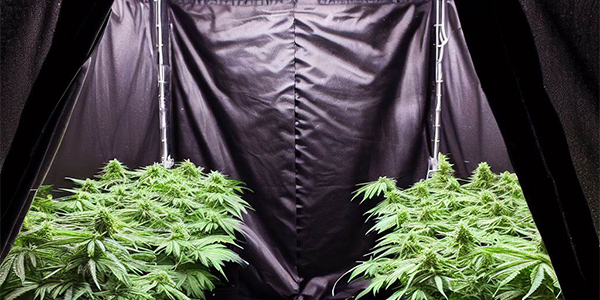
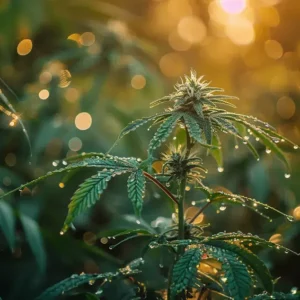
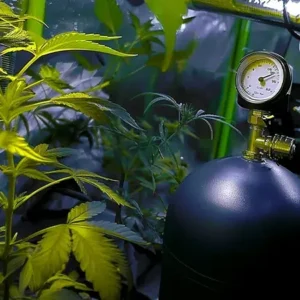
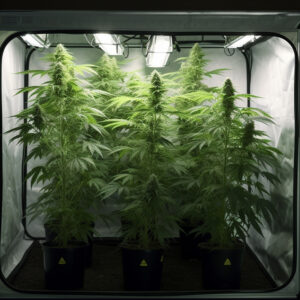
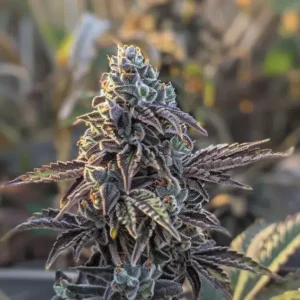
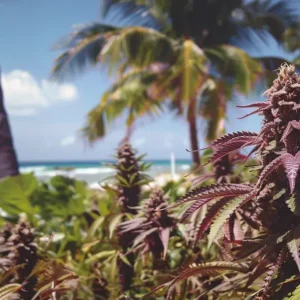
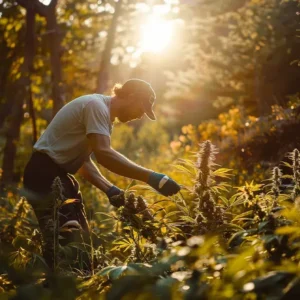
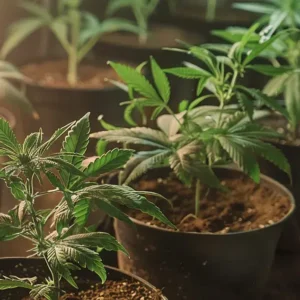
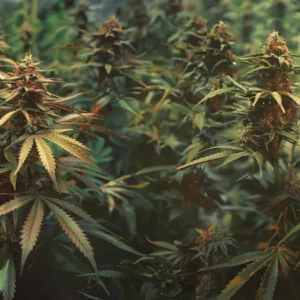

Would like to say thanks for getting me setup to grow.
Pics would help a lot